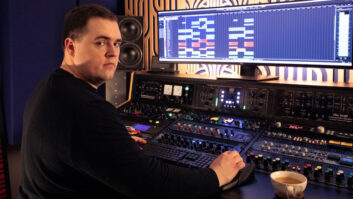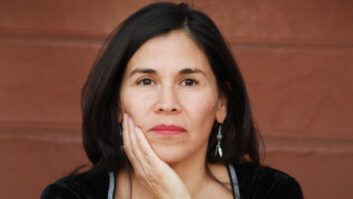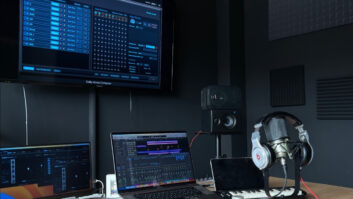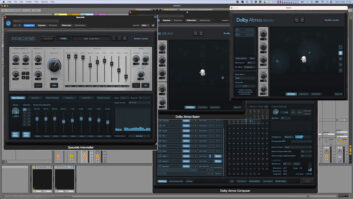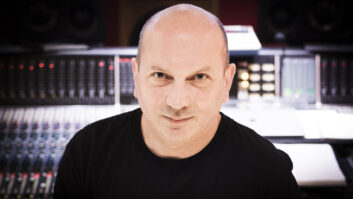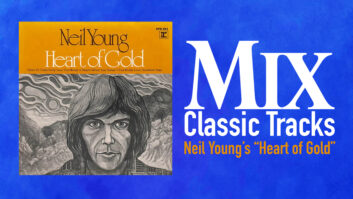In a world that seeks to pigeonhole artists, composer Christopher Young has fashioned a career as diverse as it is prolific. He is now reaping the rewards. Last year alone, he was nominated for Best Composer by the Broadcast Film Critics Association and he was nominated for a Golden Globe for Best Original Score for the Miramax film The Shipping News.
“My typecasting story was that I got trapped in the horror/thriller thing for a long time,” says Young. “The great news is, I’ve finally been able to break that.” Not that he’s complaining about his extensive catalog of dark movie scores, but progressing from films like Hellraiser and Species to Bandits and Country Bears has allowed him to expand his musical horizons.
Listen to some of Young’s recent work — the jazzy music in The Hurricane, the full-throttle orchestrations of Swordfish or the Irish folk sounds of The Shipping News — and you might be hard-pressed to say that the same composer wrote the music for all three.
“My brain is such that you could pick a CD out of your rack and send it over and say, ‘I want you to write in this style,’” says Young. “It’s both a blessing and a curse. Because we have to be jacks of all trades, [film composers] should be able to write in a variety of styles. I have the ability, as do a lot of film composers, to be thrown a style or be told that this is the attitude of the music, and to study it, absorb it and try to make it my own.”
Such skills aided Young when working with techno luminary Paul Oakenfold on two cuts for the action film Swordfish, “Music for Violence and Orchestra” (only available on a promo soundtrack CD). The collaboration, however, was developed in a rather roundabout way.
“The unfortunate thing was [Oakenfold] got involved with the film when it was still very rough, and came up with a bunch of loop concepts, demos of ideas against unfinished film,” says Young. “When the film was finally completed and ready to score, he was given permission to go off and do a concert tour. So when it came down to actually writing the score for the movie, I used some of his loops. I cut them to fit the scene with my synth guy, then flew it his way, and he made some alterations. Once the synth bed was finalized, the orchestra played along to that.”
Young says that he is not a fan of synthesized orchestrations, preferring instead to work up elaborate mockups. He never lets these demos be used as temp scores.
“I get scared when I hear [the demos], because when it’s working in my head, it’s organically sounding like an orchestra’s supposed to. Then you hear it using the samples they have available, and it invariably sounds ugly. It’s hard for me to mentally make that leap. I drive my synth guys crazy, because if it’s not sounding as close to an orchestra as it possibly can, then more work needs to be done.”
No one knows this better than Jonathan Price, Young’s engineer. “Chris doesn’t like reverb on strings at all,” says Price. “He’s okay with reverb on winds and brass to a certain extent, but a lot of the sample libraries out there are close-miked. The way that people usually create a sense of space with a close-miked sample is to add reverb. But, in this case, we don’t add a lot of reverb. It’s just trying to get the balance exactly right so that it sounds like there’s some amount of distance between the listener and the instrument, without having us swimming in reverb.”
Young’s orchestrator and main conductor is Pete Anthony, although when he goes to England, he works with Alan Wilson. His orchestral recording engineer is 30-year veteran Bobby Fernandez. Young recently expanded his studio setup, changing one of the two synth rooms into a recording space. Studio A is now the main room, with a control room and recording facilities. When an adjacent office was vacated in the building where Young and Price work, they built the recording room, which is approximately 25×15 feet, and had it soundproofed. “We basically went through to try and eliminate standing waves and flutter,” says Price. “We had some double-paned windows put in with a 30-degree tilt. The main synth area is used for the control [room], as well.”
For recording and mixing in Studio A, the duo uses Digital Performer. Young runs a Mac G4 with three ultrawide SCSI-3 removable hard drives, and he utilizes three MIDI Time Pieces, a MOTU 2408 and a Roland A-80 MIDI controller. There are two Tascam DA-88s for recording, and AKG 414 B-TL II microphones are preferred for recording live musicians. Young has a Pioneer 50-inch plasma screen, PMC speakers and uses an Aurora digital video card.
“We’ve got three 02Rs that are cascaded together,” says Price of their 120-track system. “We also have the [MOTU] 2408 audio system for capturing.” The new Studio B, a synth room where swing shift operator Haseo Nakamishi works, has one 02R for recording. The engineers share mics and cables, and they can transfer recorded material from one studio to the other.”
On the synth and sampler side, the studio has three Giga DAWs (assembled by Sound Chaser), a Roland XV5080 with orchestra card, a Nord Rack virtual analog synth, Studio Electronics SE-1, Korg Wave station, Roland R-8M, and E-mu Procussion and E6400. Effects-wise, Young’s setup includes a Roland SDE-3000 digital delay, Ensoniq DP/4+, a Yamaha Rev 7, Lexicon 300, Yamaha SPX90, an TC Electronic FireWorx and a 2290 Digital Delay.
Despite the technology around him, Young remains an old-school composer. “I’m a pencil-to-paper guy,” the composer confesses. “If you were to walk into the room that I write in, your jaw would probably drop to the ground. All I have is an upright piano, a television with a videocassette machine, a click machine that I can lock up to picture, and paper and pencil. That’s how I write.
“Certainly, I use electronics for mocking up things for show and tell,” Young continues. “But, in addition, for films like Swordfish and other action films or thrillers or horror films, those are the moments in which the electronics become a much more active part of the final score. In Swordfish, it’s obvious I’m using the drum loops, [that] I’m using the electronics to provide pulse.
“In horror films or thrillers, I resort back to my musique concrête days [in college], where I used the electronics to create these unworldly sounds. They’re atmospheres, they’re blobs of sonic blood and guts,” he says with a laugh. “That part of the usage of electronics has always fascinated me much more, where you abandon tonality. You don’t really have to worry about its commercial viability, you just embrace sound for sound’s sake, and try to figure out a way to work it into the drama of the film.”
A key factor in Young’s success is his eclectic musical background. Young began drumming around age 10, playing throughout his teenage years. Initially, he played in rock bands, but by age 17, he “got the jazz bug [and] started swinging,” he says. “I worked in a variety of eclectic jazz sextets and octets. Then, finally, my brain started thinking in pitch and harmonic thought. My initial attempts at writing were for these kinds of groups, then I graduated and moved into bigger groups of more classically oriented instruments, orchestral instruments, and studied along the way.”
Young says he discovered film music almost by accident while working in a record store in his hometown of Red Bank, N.J. He found an album entitled The Fantasy Film World of Bernard Herrmann. “I knew immediately that this was the missing link,” Young says. “That this composer, Bernard Herrmann, had accomplished everything that I was now attempting to accomplish in my own writing.”
His initial quest to collect every Herrmann recording broadened in scope. “This was pre-video, so if you wanted to listen to film music, you had to wait until The Late, Late, Late Show was on television, because they didn’t have any revival houses,” says Young. “I would record the audio track from the television onto reel-to-reel tape and then listen to it repeatedly to hear how the music worked against dialog. That and the collecting of records were my greatest educating [tools].”
While studying at UCLA Film School under David Raskin, who wrote the music for Laura and The Bad and the Beautiful, Young received the guidance and mentorship that he needed. Young, now a professor at USC, remembers his first feature project: a low-budget UCLA film called The Dorm That Dripped Blood, which featured future Melrose Place actress Daphne Zuniga.
The California-based composer’s career has progressed exponentially during the past decade. After scoring eight other features, Clive Barker’s Hellraiser (and its sequel) legitimized Young in the “horror zone” during the late 1980s. Then, the romantic thriller Jennifer 8, released in 1992, brought him into the studio world. Three years later, the 1995 Natasha Hendridge vehicle Species, a commercially successful science fiction thriller, “legitimized me in a way that none of the other movies had,” Young says. “It made a lot of money, and because [it did], the phone started ringing. I got to connect with people that wouldn’t have taken me seriously before.” This led to work on other movies, including three for director Jon Amiel: Copycat, The Man Who Knew Too Little and Entrapment. For the last, he received a BMI Scoring Award. He also garnered two Emmy nominations for scoring the telefilms Last Flight Out and Norma Jean & Marilyn.
“I would have to say that the next film that made a difference would have been The Hurricane,” says Young. “That was two years ago. That was a big enough movie and was contending for Oscar recognition; that opened up the door for the series of films I did afterward, which have all been, for the most part, top-notch.”
Young has spent a good part of 2002 with The Country Bears, a live-action take on the Disneyland attraction, featuring original songs written by John Hiatt. The film includes cameos by Elton John, Bonnie Raitt, Don Henley, Queen Latifah and Willie Nelson. Currently, Young is scoring a sci-fi thriller from Paramount entitled The Core, directed by Jon Amiel, due out around November.
Looking back at his lengthy career, Young says he has been very fortunate. “Virtually everybody gets typecast. If they get typecast in doing something they’re not liking, they will talk about their abilities to do other kinds of things. In most cases, they may never get the chance to prove whether they can or they can’t. But as we know, often when they are given the chance, it doesn’t quite work out [as they expect], and they quickly move back to what they were doing before. I’m just lucky in that I was saying, ‘I can do this! I can definitely do dramatic films or action films. Or comedies. Give me a try!’”

